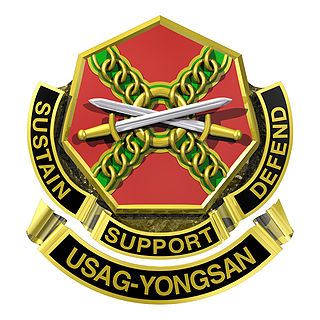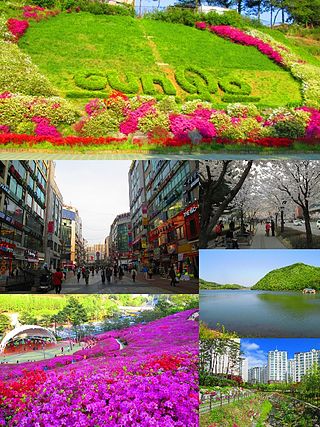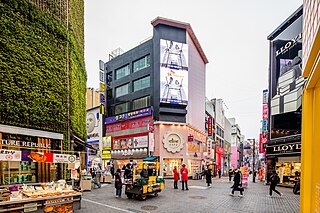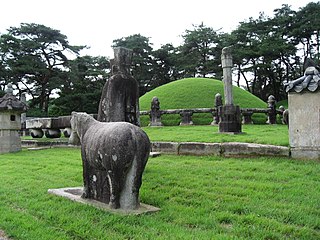
Gimpo is a city in Gyeonggi Province, South Korea. It borders Incheon, with which it shares the South Korean side of the Han River estuary, as well as Seoul and the lesser cities of Paju and Goyang. North Korea is across the Han River. The current mayor is Jeong Hayoung. The city's population of more than 300,000 is made up of more than 71,000 households.

Yongsan Garrison, meaning "dragon hill garrison", is an area located in the Yongsan District of central Seoul, South Korea. The site served as the headquarters for U.S. military forces stationed in South Korea, known as United States Forces Korea (USFK), and as United States Army Garrison Yongsan (USAG-Yongsan) until 2018, under the supervision of the U.S. Army's Installation Management Command Pacific Region. From 1910 to 1945 it served as headquarters for the Imperial Japanese Army in Korea.

Deoksugung (Korean: 덕수궁) also known as Gyeongun-gung, Deoksugung Palace, or Deoksu Palace, is a walled compound of palaces in Seoul that was inhabited by members of Korea's royal family during the Joseon monarchy until the annexation of Korea by Japan in 1910. It is one of the "Five Grand Palaces" built by the kings of the Joseon dynasty and designated as a Historic Site. The buildings are of varying styles, including some of natural cryptomeria wood), painted wood, and stucco. Some buildings were built of stone to replicate western palatial structures.

Gunpo, formerly romanized as Kunp'o, is a small city in South Korea's Gyeonggi Province, located south of Seoul in the Seoul National Capital Area. It borders Anyang to the north, Uiwang to the east, and Ansan to the south and west, and is connected to its neighbors and to Seoul by lines 1 and 4 of the Seoul Metropolitan Subway. Gunpo is also home to three stops on the Gyeongbu Line, a national railway that links it to the rest of the country. Although 73.2% of the city is greenspace, owing largely to Surisan and various smaller mountains, Gunpo is home to over 286,000 residents in several urban areas. The city's downtown core is Sanbon New Town, a commercial hub which centers on a pedestrian "street of culture" that Gunpo has designated as one of its eight scenic locations.

Gwacheon is a city in Gyeonggi Province, South Korea. It lies close to Seoul in the heart of the Seoul National Capital Area, and also lies just east of Anyang. Seoul Subway Line 4 passes through the city.

Uiwang is a city in Gyeonggi Province, South Korea. It is one of many satellite cities that ring Seoul, making up the Seoul Capital Area. Its largest immediate urban neighbor is Anyang. The low peaks of the Gwangju Mountains shape the local landscape.

Myeong-dong is a dong (neighborhood) in Jung District, Seoul, South Korea between Chungmu-ro, Eulji-ro, and Namdaemun-ro.

Sanbon-dong is a dong, or neighborhood, in Gunpo, a satellite city of Seoul in Gyeonggi Province, South Korea. Its total area is 2.05 square kilometres (0.79 sq mi). Due to its population of more than 50,000, for administrative purposes the area is divided into two dong, Sanbon 1-dong and Sanbon 2-dong. Its name can be translated as "the mountain's root," and refers to its position at the base of Surisan's eastern flank. On the other side of Surisan lies Anyang City.

Seoul National University Station is a station on Seoul Subway Line 2, located in Bongcheon-dong, Gwanak-gu of southern Seoul. This station is also known as Gwanak-gu Office Station. There are eight exits, two at each corner of the crossroads – of Nambu Beltway (Nambusunhwan-ro) and Gwanak-ro – where the station lies beneath.

The Tombs of the Joseon dynasty refers to the 40 tombs of members of the House of Yi, which ruled Korea between 1392–1910. These tombs are scattered over 18 locations across the Korean Peninsula. They were built to honor and respect the ancestors and their achievements and assert their royal authority. The tombs have been registered as an UNESCO World Heritage Site since 2009. Two other Joseon tombs, located in Kaesong, North Korea, were proposed but not submitted.

Geumjeong Station is a ground-level metro station on lines 1 and 4 of the Seoul Subway network in South Korea. The station is in Gunpo, a city approximately 15 km (9.3 mi) south of Seoul in Gyeonggi Province, between the cities of Anyang and Suwon. The name means that the land is covered with waves everywhere and that the water wets women's clothes.

Gwanghwamun is the main and largest gate of Gyeongbok Palace, in Jongno-gu, Seoul, South Korea. It is located at a three-way intersection at the northern end of Sejongno. As a landmark and symbol of Seoul's long history as the capital city during the Joseon period, the gate has gone through multiple periods of destruction and disrepair. The most recent large-scale restoration work on the gate was finished and it was opened to the public on August 15, 2010.

Guro Station (Korean: 구로역) is a subway station in Guro District in Seoul, South Korea. It serves Seoul Subway Line 1.

Pyeongchon Station is a station on the Seoul Subway Line 4. It is located in the downtown of Anyang city. Courthouse and Office of Education are near the station. The station has recently installed escalators and new exits. It is also connected to E-mart.

The Anyangcheon is a river in Gyeonggi-do and Seoul, South Korea. It has its source on the slopes of Mount Gwanggyo in the city of Uiwang and flows north, through the city of Gunpo, where a major cleanup operation saw several species of birds return to the area in 2005. Here, though, the water table remains depleted. The river then flows through Anyang City, where it is met by its major tributary, the Hakuicheon stream. From here, it loops around to the west before continuing north to the border with Gwangmyeong City. As the river passes to the west of Mount Gwanak, it forms the border between Gwangmyeong and Seoul, where it is lined on the Gwangmyeong side with rape fields and cherry blossom trees. After the stream is joined near Guil Station from the west by the Mokgamcheon stream, which forms another border between Gwangmyeong and Seoul, it is then totally within the capital. Here, it is also joined from the east by the Dorimcheon and passes through a conservation zone for migratory birds which was established after a 2005 cleanup operation, whereafter it joins the Han. Most of the length of the river has a path alongside providing easy access, the only parts without this lying in Uiwang. Seoul City Council has embarked on a programme of exclusive cycle path creation alongside its waterways, including the Anyangcheon, to be completed in 2010.

Seojeongni Station is a station in Seojeong-dong, Pyeongtaek, South Korea. Mugunghwa-ho trains running on the Gyeongbu Line stop here. Additionally, services on Seoul Subway Line 1 have been calling at this station since 2005. Its station subname is Kookje College.

Dangjeong Station is an infill station on the Seoul Metropolitan Subway Line 1. It serves the city of Gunpo in Gyeonggi Province, South Korea and is the subway station closest to Hansei University.

Surisan Station is a railway station on Seoul Subway Line 4. It is between Sanbon Station and Daeyami Station. Opened on July 18, 2003, Surisan station's name comes from Surisan, which is not too close to the station. It was also made to reflect the opinions of local residents.

Daeyami Station is a railway station on Seoul Subway Line 4, located in Gunpo city. It is between Surisan Station and Banwol Station. The station only serves Northbound and Southbound services on one line. The name of the subway station comes from its local name. Regional names refer to the size of small fields.

Surisan (Korean: 수리산) is a mountain separating the cities of Anyang and Gunpo in Gyeonggi Province, South Korea. Surisan is 488 metres (1,601 ft) above sea level (a.s.l.). Surisan is also known as Gyeonbulsan.





















